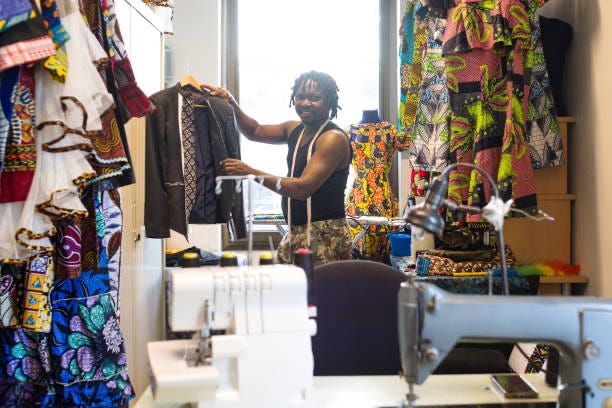$6 billion fashion market: 6 ways Nigerians are dressing up—and who is really funding it
Esther Emoekpere
Nigeria’s fashion market is estimated to be worth between $2.5 billion and $6 billion annually, making it a significant and fast-growing part of the country’s economy. Yet, this market is far from uniform, it is composed of diverse consumer groups and sellers ranging from informal thrift traders and small-scale tailors to high-end boutiques and luxury brands. Each group dresses in its own distinctive way, shaped by factors such as income levels, cultural identity, and access to different fashion channels. Despite the size of the market and strong consumer demand, the sector remains largely informal and undercapitalised, with much of its potential untapped.
Drawing on insights from Consonance’s recent research on undercapitalised growth sectors in Nigeria, this article explores six distinct ways Nigerians are dressing up this multi-billion-dollar fashion economy. More importantly, it reveals who is really funding the sellers and businesses behind the scenes, from grassroots traders to elite fashion houses.
The thrift and tailor-made hustle
This segment represents the largest share of Nigeria’s fashion market, accounting for an estimated 40–45% of consumer activity. Made up largely of low- to middle-income earners, these shoppers typically spend between ₦36,000 and ₦100,000 annually on clothing. Their fashion choices are driven by affordability and access, with popular shopping spots including Katangua market,bend-down-select stalls, and neighbourhood tailors. Sellers in this space operate within an informal, cash-based economy, funding their businesses through personal savings, ajo (rotational thrift contributions), cooperative societies, or small, short-term informal loans. The model is highly entrepreneurial but also vulnerable, relying on day-to-day turnover and tight inventory management to stay afloat.
The urban professionals
This group, made up largely of salaried workers in sectors like banking, tech, and media, sees fashion as both a personal statement and a tool for professional influence, accounting for about 20–25% of Nigeria’s fashion market. Spending between ₦150,000 and ₦1.5 million annually, they often shop from Instagram stores, WhatsApp groups, and small e-commerce platforms, custom designers, tailors, and mid-tier imported brands. Their purchases are typically funded through monthly salaries, side hustles, and increasingly, Buy Now Pay Later (BNPL) options offered by fintech platforms. On the supply side, many sellers catering to this demographic operate as registered, mid-size fashion businesses. These businesses rely on digital payment systems like POS, access retail loans, and in some cases, secure early-stage investment from angel investors looking to tap into Nigeria’s growing fashion economy.
The creative class
Comprising influencers, entertainers, and Gen Z creatives, this group accounts for just 5–7% of the fashion market, but their cultural and trendsetting impact is outsized. They typically shop from online boutiques, Instagram stores, vintage shops, and work closely with stylists. Their annual fashion spend ranges from ₦600,000 to ₦3 million or more, often funded by brand deals, freelance gigs, or influencer marketing campaigns. In many cases, clothing is received in exchange for visibility through sponsorships or collaborations. Sellers who cater to this group depend on pre-orders, social media promotion, and partnerships with stylists and content creators to remain relevant and fund their operations.
The high net-worth shopper
This ultra-affluent segment,comprising less than 1% of the market—includes politicians, top executives, and diasporans who spend between ₦4 million and ₦20 million or more on fashion annually. Their shopping is handled through personal shoppers, luxury stylists, and high-end international brands. Purchases are typically funded via business profits, international credit cards, or offshore accounts. Vendors catering to this elite clientele often operate like concierge services, sourcing directly from fashion capitals like Milan and Paris. Many fund their operations with venture capital, private equity, or family-backed wealth.
The event traditionalist
Cutting across multiple income brackets, the event traditionalist is a key player in Nigeria’s fashion economy, particularly in the context of weddings, funerals, and cultural celebrations. Accounting for 60-70% of events per year, these buyers typically spend between ₦150,000 and ₦5 million or more on fashion annually, although spending is event-based rather than consistent throughout the year. Shopping habits revolve around aso-ebi sellers, fabric vendors, and heritage designers. Purchases are often funded through pooled family resources, allocated event budgets, or communal contributions. Vendors in this space rely on bulk orders, upfront payments, and informal lines of credit to meet demand during peak celebration seasons.
The fabric entrepreneur
At the intersection of fashion and heritage, fabric entrepreneurs are leveraging Nigeria’s indigenous textiles—such as adire, ankara, lace, and aso-oke—to build sustainable fashion businesses. This sector holds great promise for both cultural preservation and export potential. Fashion in this category is produced and sold in markets like Aba, through cottage industries and textile hubs scattered across the country. Funding sources vary widely and include personal savings, NGO support, creative grants, and loans. These entrepreneurs are increasingly visible at cultural expos and global trade shows.
BusinessDay NG



